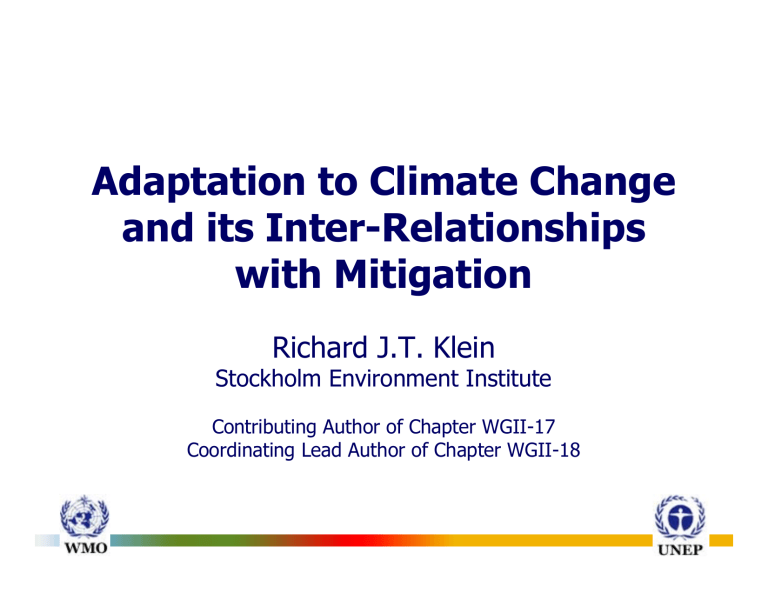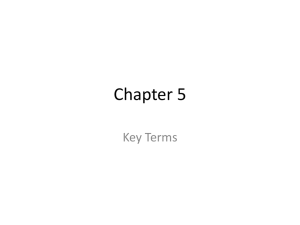Adaptation to Climate Change and its Inter-Relationships

Adaptation to Climate Change and its Inter-Relationships with Mitigation
Richard J.T. Klein
Stockholm Environment Institute
Contributing Author of Chapter WGII-17
Coordinating Lead Author of Chapter WGII-18
17: Assessment of Adaptation Practices,
Options, Constraints and Capacity
• Builds on the Third Assessment Report, retains definitions and concepts
• A much greater and spatially varied literature base than for the TAR, including studies on
• actual adaptations
• planned adaptations
• vulnerability and adaptive capacity
• policy developments
• A stronger focus on implementation issues
Adaptation to climate change is already taking place, but on a limited basis
• Societies have a long record of adapting to the impacts of weather and climate
• Examples include crop diversification, irrigation, water management, disaster risk management and insurance
• Adaptation is carried out by public and private actors through policies, investments in infrastructure and technology, and behavioural change
• Adaptation measures are seldom undertaken in response to climate change alone
Climate change poses novel risks, often outside the range of experience
• Novel risks, such as droughts, heatwaves, accelerated glacier retreat, permafrost melt, increased hurricane intensity and new disease vectors, require forwardlooking investment and planning responses
• Adaptations to these novel risks are taking place
• partial drainage of the Tsho Rolpa glacial lake, Nepal
• changes in livelihood strategies by the Inuit in Nunavut
• increased use of artificial snow making in the ski industry
• Some adaptations include scenarios of future climate
• Confederation Bridge, Canada
• Deer Island sewage plant, Boston, USA
• Qinghai-Tibet railway, China
Many adaptations can be implemented at low cost, but no comprehensive estimates of costs and benefits exist
• There is a growing number of adaptation cost and benefit estimates at regional and project level
• sea-level rise
• agriculture
• energy demand for heating and cooling
• water resource management
• These studies identify a number of measures that can be implemented at low cost or with high benefit-cost ratios
• However, there may be social and environmental externalities ( e.g.
, air-conditioning)
Sea-level rise protection costs in 2080
Micronesia
Palau
Tuvalu
Marshall Islands
Mozambique
French Polynesia
Guinea-Bissau
Nauru
Guyana
New Caledonia
A1FI
7.4
6.1
1.4
0.9
0.2
0.6
0.1
0.3
0.1
0.4
A2
10.0
7.0
1.7
1.3
0.5
0.8
0.3
0.4
0.2
0.3
(% of GDP)
B1
5.0
3.9
0.9
0.6
0.1
0.4
0.0
0.2
0.1
0.2
B2
13.5
9.1
2.2
1.7
0.8
1.0
0.6
0.6
0.4
0.4
Adaptive capacity is uneven across and within societies
• There are individuals and groups in all societies that have insufficient capacity to adapt to climate change
• Multiple stresses ( e.g.
, HIV/AIDS, land degradation, economic globalisation, violent conflict) adversely affect exposure to climate risks and the capacity to adapt
• National indicators of vulnerability and adaptive capacity fail to capture many relevant factors and processes, and thus provide little insight at the level where most adaptations will take place
There are substantial limits and barriers to adaptation
• High adaptive capacity does not necessarily translate into actions that reduce vulnerability
• Limits and barriers to adaptation include the inability of natural systems to adapt to the rate and magnitude of climate change, as well as technological, financial, cognitive, behavioural, social and cultural constraints
• There are also significant knowledge gaps for adaptation
Research needs
• Monitor progress on adaptation and assess its direct and ancillary effects
• Synergies and trade-offs between various adaptation measures, and between adaptation and other development priorities
• Effect of human intervention to manage the process of adaptation in natural systems
• Economic and social costs and benefits of adaptation, in particular non-market costs and benefits
• Implications of adaptation on economic growth and employment
18: Inter-relationships between
Adaptation and Mitigation
• A new chapter compared to the Third Assessment
Report
• Inclusion in the Fourth Assessment Report motivated by explicit policy questions
• trade-offs and synergies
• timing of investments
• substitutability and optimality
• Literature base rather small, yet very diverse, and inconsistent in its conclusions
• integrated assessment modelling
• empirical research
• policy analysis
Effective climate policy involves a portfolio of adaptation and mitigation
• Adaptation and mitigation actions include
• technological, institutional and behavioural options
• the introduction of economic and policy instruments to encourage the use of these options
• research and development to reduce uncertainty and to enhance the options’ effectiveness and efficiency
• Four types of inter-relationships can be distinguished
• mitigation actions that have consequences for adaptation
• adaptation actions that have consequences for mitigation
• decisions that include trade-offs and synergies between adaptation and mitigation
• processes that have consequences for both adaptation and mitigation
Decisions on adaptation and mitigation are taken at different governance levels
• Most adaptation involves private actions of affected entities, public arrangements of impacted communities and national policies
• Mitigation is primarily driven by international agreements and ensuing national policies, possibly complemented by unilateral and voluntary actions
• Both adaptation and mitigation take place within a broader development context; people’s capacities to adapt and mitigate are influenced by development pathways
Synergies can increase the costeffectiveness of adaptation and mitigation
• However, synergies provide no guarantee that resources are used in the most efficient manner when seeking to reduce climate risks
• Opportunities to create synergies are greater in some sectors ( urban infrastructure) but are limited in other ones
( e.g.
e.g.
, agriculture and forestry, buildings and
, coastal systems, energy, health)
• The ability to create synergies is limited by the absence of a relevant knowledge base and of human, institutional and organisational capacity
It is not yet possible to say whether or not adaptation buys time for mitigation
• Integrated assessment models provide approximate estimates of relative costs and benefits at highly aggregated levels, but only a few models include feedbacks from impacts
• Challenges to making trade-offs beyond the local scale include the different spatial, temporal and institutional scales of options and the different interests, beliefs, value systems and property rights of actors
• An “optimal mix” would reconcile welfare impacts on people living in different places and at different points in time into a global aggregate measure of well-being
Social and economic development enhances capacity to adapt and mitigate
• Response capacity is often limited by a lack of resources, poor institutions and inadequate infrastructure
• People’s vulnerability to climate change can therefore be reduced not only by adaptation and mitigation, but also by development aimed at improving the living conditions and access to resources of those experiencing the impacts
Research needs
• Development of a consistent analytical framework to analyse inter-relationships between adaptation and mitigation, including their potential and limitations
• Empirical analysis of each of the four types of interrelationships, in particular at the regional and sectoral levels, and for specific social and economic groups
• The effect of development pathways on adaptation and mitigation, and vice versa
• Requirements on national and international policy in facilitating decisions on adaptation and mitigation at the relevant institutional levels
Thank you very much richard.klein@sei.se


